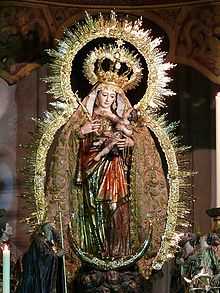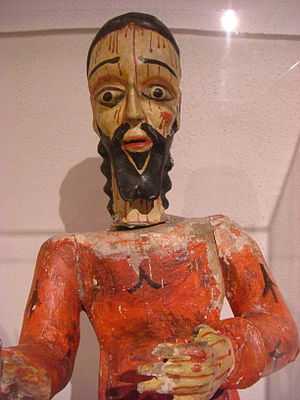Santo (art)

Santo (English: Saint) are various religious artforms found in colonized parts of Spain consisting of wooden or ivory statues that depict various saints, angels, or Marian titles or one of the personages of the Holy Trinity. A Santero refers to a wood-carver who makes the image, but has also come to be known as someone who collects Santo images either as a religious devotion, or artistic hobby, or both. Some Santo images which have gained greater public devotion among the faithful have also merited Papal approval through Canonical Coronations.
History
Icons and other religious images were crucial for the conversions of indigenous peoples to Roman Catholic Church, which was itself an integral part of the Spanish colonization of the Americas. However, long distances, inefficient methods of transportation, and high demand for such artworks limited the ability of ecclesiastical authorities to supply parish churches, especially those in remote outposts, with works of religious art from the Kingdom of Spain.
The practice of creating Santo objects began in Spain, where mannequin style religious images were commonly vested in ornate religious clothing, often expensive and funded by religious devotees. An early known example is the 1555 statue of Infant Jesus of Prague, already vested during the time of Saint Teresa of Avila. Customarily, jewels are various accessories were also added onto the image, a tradition still carried today.
Santo images are also common throughout Latin America and the Caribbean, while the tradition of santo carving was preserved as a folk art in Northern New Mexico, whose isolated villages remain secluded to this day. Of particular note is the village of Cordova which has produced several well-known Santeros (carvers of santos). A major one was George López, who was awarded the National Heritage Fellowship by the National Endowment for the Arts in 1982.
Santo statues are commonly known as revultos or informally as bultos. They are usually carved from cottonwood root, pine or aspen. A Santero carves a bulto with a knife and then covers it with gesso, a mixture of native gypsum and glue, to prepare it for painting. Some contemporary santeros still use paints from homemade pigments.[1]
In the Philippines



The Santero culture in the Philippines is widely prevalent among Filipino Catholics, having been influenced by colonial Spain and various forms of folk Catholicism. In the Philippines, the earliest record for a vested Santo image is the Santo Nino de Cebu, a baptismal gift given by Ferdinand Magellan in 1521.
During the Spanish era of the Philippines, only the noble and wealthy often could afford Santo images, due to their elaborate ornamentation and design. To this day, the cost of Santo image and its maintenance is commonly thought to be costly. The most expensive to the type of Santo are the ones made of Marfil or ivory, due to its present scarcity and government ban from 1981.
Types of statue
Among wooden Santo images, two distinct types are often noted. A mannequin style or fully detail-painted ("Detallado or Estofado") statue. Mannequin style statues often have removable arms, and movable limbs, sometimes caged into a frame to build shape and is often referred to as Bastidor or cage-style. A detallado image is one fully painted, fully carved and needs no vestment dresses or robes.
Materials
The most economical type of santo images are made of resin or fiberglass, as they are geared toward mass-production. With wooden santo, the cottonfruit or Santol is an often favourite, but the Mangeao wood or Batikulin is well-sought and is even more expensive as a non-termite penetrating type of wood.
Ivory is often cited as the best and most expensive material of Santo images. Ivory elephant tusks, especially of African origins are banned to sell, distribute, or commercialize in the Philippines since 1981. The smuggle of ivory goods into the country is a legal crime punishable by law in the Philippines.
For the crowns and metal accessories associated with Santo images, the most inexpensive type are the plastic crowns. Another crown used is made of aluminum tin, often gold-plated for a richer effect. The more expensive type is made of solid brass, and Pukpok (or hammered) by an artisan for a richer effect. The most expensive type of crowns are that made of solid sterling silver or gold, often reserved for the wealthy clerics and cathedrals nationwide.
Attire and accessories
The wardrobe of the Santo images are often expensive, such as the ones woven with gold thread, the most expensive type known as "Inuod" (Filipino: "Wormed"), which is a form of French gold bullion thread used to make embroidered floral patterns on the image's dress or vestment.
Crowns are also an integral part of a Santo image, often decorated with faux jewels and rhinestones to symbolize the spiritual wealth of the saint. The most common crown associated with saints are the Aureola or halo. In addition, there is also a Corona or gold crown. A face resplendor or rostrillo is often cited as the metal decoration surrounding the perimeter of the face. There is also a baton or scepter, and sometimes a Luna or moon-shaped headband. For the images of Jesus Christ, the most common accessories are the Tres Potencias or three powers symbolizing the Holy Trinity.
Another costly addition to Santo images are the Carroza or carriage, often used during religious processions most notably on Holy Week services.
From a religious perspective, the practice of owning and maintaining Santo images are often regarded as a mild Catechism for people, especially with regards to the iconic attributes attached to the images. A caretaker of a Santo image is often referred to as Camarero (female: "Camarera"), a Spanish term for "chamber-person").
The most well known Santo images in the Philippines are often Marian titles, such Our Lady of Manaoag and Our Lady of La Naval de Manila, and Christological ones such Santo Nino de Cebu and the Black Nazarene.
Conflict
Many religious individuals who practice collecting and maintaining Santo images are often Gay Catholics,[citation needed] and endorse such devout practice it as a form of religious piety in their community or Barangay neighborhood. Because the practice of Santero culture sometimes borders on pageantry, conflicts often arise with regards to the sincerity of Santo-image collecting, which some argues to be either idolatry or simply artwork-collecting.
Common issues that arise among these conflicts are the use of particular vestments, colours, iconography, changing of titles, or using the movable-bodies as a form of "barbie" mannequins rather than as sacred works of religious artwork. At times, innovative additions like flowers and non-religious paraphernalia are also cited as issues of conflict among its devotees. One example is the Issue of "transformation" of sacred images into another form, by changing or switching the titles of a particular Saint or Marian title depending on its feast day or for the purpose of Holy Week is also deemed unacceptable among many Santo enthusiasts and caretakers.
Another contentious issue among caretakers of Santo, are the association of specific iconic attributes to a saints image. An issue often cited for conflict are the replacement or traditional iconic attributes to a saint with self-interpreted accessories or "innovations" generally deemed as heretical or disrespectful of traditional Catholic iconography associated with that particular image, often driven by reinterpreation, folk mysticism, or over-pageantry.
See also
References
External links
- "Santos" at the Getty Thesaurus of Art and Architecture
- Contemporary bultos at Museum of New Mexico